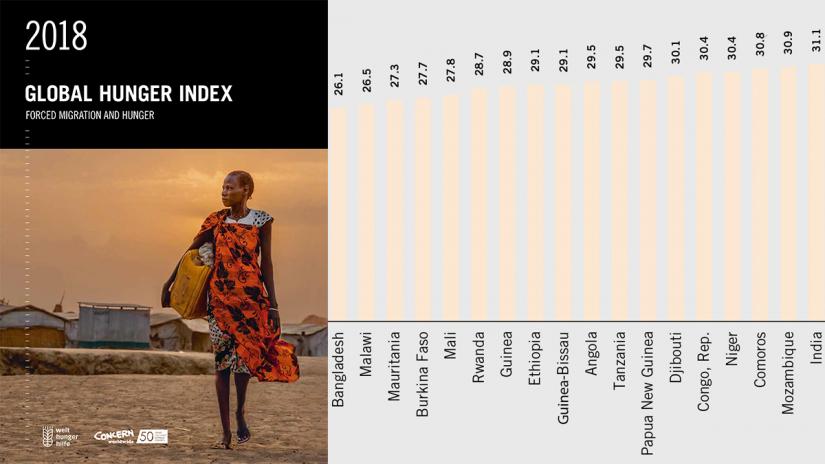 Bangladesh has maintained a steady progress in tackling hunger as the country has moved two notches up to 88th spot among 119 countries in the 2018 Global Hunger Index (GHI), reports BSS.
Bangladesh has maintained a steady progress in tackling hunger as the country has moved two notches up to 88th spot among 119 countries in the 2018 Global Hunger Index (GHI), reports BSS.
According to the report, Bangladesh is ahead of India and Pakistan as these two neighbouring countries have been ranked 103rd and 106th places in 2018 GHI, a tool designed to comprehensively measure and track hunger at global, regional, and national levels.
In 2017 GHI, Bangladesh’s rank was 86 while the positions of India and Pakistan were 100 and 106, said a press release.
The 2018 GHI – published jointly by Concern Worldwide and Welthungerhilfe – scores are calculated each year to assess progress and setbacks in combating hunger. The 2018 edition has a special focus on the theme of forced migration and hunger.
The 2018 GHI indicates that the level of hunger and undernutrition worldwide falls into the serious category, at a value of 20.9, down from 29.2 in 2000.
Underlying this improvement are reductions since 2000 in each of the four GHI indicators – the prevalence of undernourishment, child stunting, child wasting, and child mortality.
GHI is designed to raise awareness and understanding of the struggle against hunger, provide a way to compare levels of hunger between countries and regions, and call attention to those areas of the world where hunger levels are highest and where the need for additional efforts to eliminate hunger is greatest.
Considered a lower-middle-income country – Bangladesh experienced rapid GDP growth. Country’s poverty rate plunged from 34.8 percent to 14.8 percent.
Since 2016, the Bangladeshi economy has faced formidable challenges, including above-average flooding that has been detrimental to agriculture, increasing rice prices and the influx of Rohingya refugees from Myanmar, of whom nearly 900,000 are now in Bangladesh.
Because of its densely populated, lowlying coastal landmass, it is also considered one of the world’s most vulnerable countries to the effects of climate change and rising sea levels.
Poverty has declined primarily in rural areas, especially for rural households involved mainly in industry or services rather than in agriculture.
Zimbabwe, Somalia, and CAR have the highest rates of under-nourishment, ranging between 46.6 and 61.8 percent.
Stunting rates are highest in Timor-Leste, Eritrea, and Burundi, with at least half of the children suffering from stunting in each country.
Wasting is most prevalent in Djibouti, India, and South Sudan, but even among these three countries the rates and estimates vary widely, at 16.7 percent, 21.0 percent, and 28.6 percent, respectively.
Finally, the highest under-five mortality rates are in Somalia (13.3 percent), Chad (12.7 percent), and CAR (12.4 percent).
 National
National
30710 hour(s) 40 minute(s) ago ;
Morning 09:34 ; Thursday ; Apr 18, 2024
Bangladesh moves two notches up in Global Hunger Index
Send
Bangla Tribune Desk
Published : 20:35, Oct 16, 2018 | Updated : 21:20, Oct 16, 2018
Published : 20:35, Oct 16, 2018 | Updated : 21:20, Oct 16, 2018
0 ...0 ...
/hb/
Topics: Top Stories
- KOICA donates medical supplies to BSMMU
- 5 more flights to take back British nationals to London
- Covid19: Rajarbagh, Mohammadpur worst affected
- Momen joins UN solidarity song over COVID-19 combat
- Covid-19: OIC to hold special meeting
- WFP begins food distribution in Cox’s Bazar
- WFP begins food distribution in Cox’s Bazar
- 290 return home to Australia
- Third charter flight for US citizens to return home
- Dhaka proposes to postpone D8 Summit
Unauthorized use of news, image, information, etc published by Bangla Tribune is punishable by copyright law. Appropriate legal steps will be taken by the management against any person or body that infringes those laws.
Bangla Tribune is one of the most revered online newspapers in Bangladesh, due to its reputation of neutral coverage and incisive analysis.
F R Tower, 8/C Panthapath, Shukrabad, Dhaka-1207 | Phone: 58151324; 58151326, Fax: 58151329 | Mob: 01730794527, 01730794528


